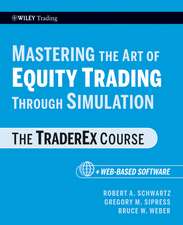Coping With Institutional Order Flow: Zicklin School of Business Financial Markets Series
Editat de Robert A. Schwartz, John Aidan Byrne, Antoinette Colaninnoen Limba Engleză Paperback – 13 noi 2014
| Toate formatele și edițiile | Preț | Express |
|---|---|---|
| Paperback (1) | 941.38 lei 6-8 săpt. | |
| Springer Us – 13 noi 2014 | 941.38 lei 6-8 săpt. | |
| Hardback (1) | 947.35 lei 6-8 săpt. | |
| Springer Us – 24 iun 2005 | 947.35 lei 6-8 săpt. |
Din seria Zicklin School of Business Financial Markets Series
- 18%
 Preț: 945.62 lei
Preț: 945.62 lei - 15%
 Preț: 629.10 lei
Preț: 629.10 lei - 15%
 Preț: 640.37 lei
Preț: 640.37 lei - 18%
 Preț: 946.87 lei
Preț: 946.87 lei - 15%
 Preț: 637.59 lei
Preț: 637.59 lei - 18%
 Preț: 945.62 lei
Preț: 945.62 lei - 18%
 Preț: 931.39 lei
Preț: 931.39 lei - 18%
 Preț: 935.53 lei
Preț: 935.53 lei - 20%
 Preț: 548.76 lei
Preț: 548.76 lei - 15%
 Preț: 639.73 lei
Preț: 639.73 lei - 15%
 Preț: 637.93 lei
Preț: 637.93 lei - 20%
 Preț: 550.76 lei
Preț: 550.76 lei - 18%
 Preț: 884.56 lei
Preț: 884.56 lei - 18%
 Preț: 887.24 lei
Preț: 887.24 lei - 15%
 Preț: 695.19 lei
Preț: 695.19 lei - 15%
 Preț: 636.80 lei
Preț: 636.80 lei
Preț: 941.38 lei
Preț vechi: 1148.02 lei
-18% Nou
Puncte Express: 1412
Preț estimativ în valută:
180.18€ • 185.68$ • 152.12£
180.18€ • 185.68$ • 152.12£
Carte tipărită la comandă
Livrare economică 03-17 martie
Preluare comenzi: 021 569.72.76
Specificații
ISBN-13: 9781461499794
ISBN-10: 1461499798
Pagini: 220
Ilustrații: XV, 200 p.
Dimensiuni: 152 x 229 x 12 mm
Greutate: 0.33 kg
Ediția:2005
Editura: Springer Us
Colecția Springer
Seria Zicklin School of Business Financial Markets Series
Locul publicării:New York, NY, United States
ISBN-10: 1461499798
Pagini: 220
Ilustrații: XV, 200 p.
Dimensiuni: 152 x 229 x 12 mm
Greutate: 0.33 kg
Ediția:2005
Editura: Springer Us
Colecția Springer
Seria Zicklin School of Business Financial Markets Series
Locul publicării:New York, NY, United States
Public țintă
Professional/practitionerCuprins
Evidence on Institutional Trading Practices.- Interaction Between Investment and Trading Decisions.- How Best to Integrate the Order Flow.- New Systems for Institutional Investors.- The Evolution of the Modern Nasdaq.- Overcoming Resistance to Change.- Nyse Market Structure and Services.- Best Execution: A Candid Analysis.
Notă biografică
Robert A. Schwartz is Marvin M. Speiser Professor of Finance and University Distinguished Professor in the Zicklin School of Business, Baruch College, CUNY. Before joining the Baruch faculty in 1997, he was Professor of Finance and Economics and Yamaichi Faculty Fellow at New York University's Leonard N. Stern School of Business, where he had been a member of the faculty since 1965. Professor Schwartz received his Ph.D. in Economics from Columbia University. His research is in the area of financial economics, with a primary focus on the structure of securities markets. He has published numerous journal articles and eleven books, including Equity Markets in Action: The Fundamentals of Liquidity, Market Structure and Trading, Wiley & Sons, 2004, and Reshaping the Equity Markets: A Guide for the 1990s, Harper Business, 1991 (reissued by Business One Irwin, 1993). He has served as a consultant to various market centers including the New York Stock Exchange, the American Stock Exchange, Nasdaq, the London Stock Exchange, Instinet, the Arizona Stock Exchange, Deutsche Börse, and the Bolsa Mexicana. From April 1983 to April 1988, he was an associate editor of The Journal of Finance, and he is currently an associate editor of the Review of Quantitative Finance and Accounting, the Review of Pacific Basin Financial Markets and Policies, and The Journal of Entrepreneurial Finance & Business Ventures, and is a member of the advisory board of International Finance. In December 1995, Professor Schwartz was named the first chairman of Nasdaq's Economic Advisory Board, and he served on the EAB until Spring 1999.
Textul de pe ultima copertă
Handling the large orders of institutional participants presents some of the most complex problems for system design. How well are our current systems operating, and how effective are new facilities on the scene? To what extent is market quality impaired for all participants when institutional trading costs are not properly contained? Can institutional order flow be efficiently integrated with the orders of retail customers, or are separate facilities needed? What are the impediments to market structure change, and how might they best be overcome? These are some of the questions addressed, and in so doing, Coping With Institutional Order Flow considers major ways in which to improve the efficiency of our equity markets.
Caracteristici
U.S. equity markets Financial economics Structure of securities markets Includes supplementary material: sn.pub/extras












